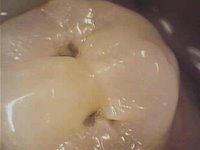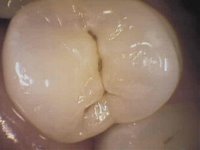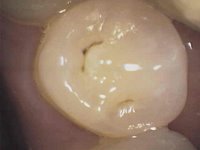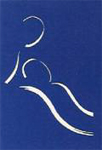07 July 2007
Dental Implant crown
30 June 2007
Invisible tooth mending after laser detection
 .
.After putting the tooth to sleep using "The Wand", the area was carefully cleaned out using micro-techniques.

Here the tooth is free of any decay

More about early Laser Tooth Decay Detection
In order to maintain them, the earliest possible care is essential. DIAGNOdent aids in the detections of tooth decay.
Even very small cavities are detected at the earliest stage, enabling us to protect and preserve the tooth substance.
How is it used?
Your stained tooth is "read" by the Diagnodent mini-laser. This is entirely painless and much better than an old-fahioned dentist probe.
It is safe and helps decide if the stain is safe to leave or requires attention.
You may have one or more unfilled tooth which have stained grooves (fissures)
Tea, coffee or red-wine stains and can be safely left or just cleaned. Sometimes tooth decay can begin under the stain and will not become obvious until it has become quite deep, The Diagnodent Laser Detector tells us what is happening.
Dental x-rays WILL NOT show tooth decay at this early stage.
If there are changes in the enamel, this can be skimmed , without anaesthetic, and sealed to prevent further progress.
If the Laser reading are higher then the decay process will be deep enough to warrent a filling, often a very fine one.
What happens at my dental check-up?
The dentist decides how many teeth would benefit from the Diagnodent laser check.
A prescription is written for our dental hygienist detailed which teeth are to be checked.
She will carefiully clean the fissures of each of these teeth.
The Diagnodent laser is used to examine each tooth.
The Diagnodent readings are noted in your records.
Your results are reviewed by the dentist.
The dentist decides what if any advice or treatment each tooth needs.
The cost of any recommended preventive or corrective treatment will be set out for you.
Your will be informed of your results by post or e-mail and invited to make any appointments you might need
DIAGNODENT SHOWING TREATMENT NEEDED
24 June 2007
Temporary Website and Smile Gallery
smile transformation pictures here
17 June 2007
Dental Topics No.1 Dental Implants -Reprise
I first published this item in the practice e-zine in 2005 but felt it could be of interest again especially to newer patients of the practice.
If you have one or more missing teeth this section should be of some interest !
We have been offering dental implants, for the benefit of our patients, at St. Mary's House since 1998/9. Dental Implants are a rapidly growing area of dentistry , offering more acceptable solutions to the problems of tooth loss for many people.
There are many implant systems for dentists to choose from. The ones I use at present are designed and manufactured by NobelBiocare. Click on the link below to find out much more and if dental implants could help you or someone close to you.
Dental Implants by Nobelbiocare.
Also as a member of the Association of Dental Implantology (ADI) I have access to the most up to date impartial information and teaching on dental implants. I regularly attend Study Clubs, symposia, seminars and conferences specifically focused on implant dentistry.
You will find comprehensive information about what dental implants are and how they can be used and all the other whys and wherefores at the ADI website. Just click here:
Association of Dental Implantology(UK)
The ADI produce helpful information leaflets which you can pick up from the practice or download in pdf form here:
For a general overview about implants:
http://www.adi.org.uk/public/implant/patient1page.pdf
For a more detailed explanation
http://www.adi.org.uk/public/implant/patientinfo.pdf
Please feel free to contact us for more information or a consultation
Prevention is better than cure
Providing the latest and best services to our patients is one of our goals.
So as part of our recent investment program we have acquired a brand new, high tech tool that allows us to find cavities on the chewing surfaces of back teeth, even when they just beginning, and would have been missed by previous detection methods.
The DIAGNOdent is a small portable laser detector which catches your tooth cavities with a beam of laser light
The DIAGNOdent can detect these cavities and alert us with an audible signal and also provide a numerical readout, so we have an idea of it's size.
The value is that we can stop cavities in their infancy, whereas in the past they would have to be significantly bigger before we could find and treat them.
Just like other areas of medicine and dentistry, early detection and treatment is always the best way forward.
The DIAGNOdent laser is a detecting device. The advanced laser can detect decay earlier than more conventional methods. In fact, it can find 50% of the decay that goes undetected by present diagnostic methods. This laser is truly valuable in the prevention of Dental problems and the promotion of good oral health.
How we use it.
Here is a tooth which has a stained natural fissure and which may have a hidden hole beneath the stain. 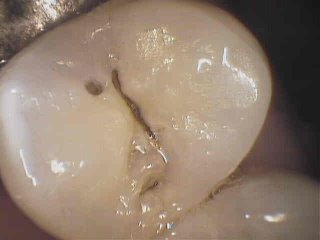
If you have this type of stained fissure , we will arrange an appointment with our Dental Hygienist , Nicky Smith.
The first step is to gently remove the stain. We do this with a mini-air jet washer which showers the fissure area with fine spray of bicarbonate of soda and water.
Once the fissure is cleaned, the delicate tip of the Diagnodent laser reader, is passed over the fissure and a reading is taken which indicates whether there is only a surface stain or whether there is definitely a cavity and if so how deep it might be.
If it is shallow then we will try to prevent it progressing. If it turns out to be a little deeper then you will benefit by a mininmally invasive, sealant-type repair can be carried out. We will only recommend a filling if it is essetial at an early stage. A stitch in time!
In this case a tooth coloured resin is bonded to the tooth after skimming away any soft surface enamel or dentine. This does not normally need any anaesthetic !
What about these? Are these cavities or stains?
The Diagnodent will tell us !
08 June 2007
Your teeth in their hands -ongoing training and education


22 March 2007
"Coming of Age"
The spring months have been busy for us as we put the finishing touches to the practice re-vamp.You'll notice the changes as you come in.
Our team have recently had an article published on our experiences of helping anxious patients using "RA". ,in a new journal aimed at Dental Nurses, called, not surprisingly, Dental Nursing!
The team photo above is included and was beamed out across the nation's dental practices in April, which will certainly put us on the map.
On a different note, we are in a position to offer appointments to new patients so please recommend us to friends or family if you feel they would appreciate our style of dental practice.
We look forward to welcoming you at your next visit.
Richard Charon
20 February 2007
Acid erosion - save your teeth and your money !

This is mild erosion which needs no active treatment, just a change of eating habits or perhaps attending to a medical condition. The tooth is beginning to lose its natural enamel cover and has a more rounded shape.
More marked erosion, depending on which part of the tooth is affected, may need some simple treatment such as bonding tooth-coloured fillings to seal and protect the eroded surface and to re-instate the original shape.
Severe erosion may be disfiguring, if front teeth are affected. If back teeth are affected, eating may become painful and a change facial appearance can occur. A sort of premature ageing. Faciall height is reduced as if the teeth had worn down over many years and the chin gets closer to the nose !
Porcelain or resin veneers, crowns or onlays may be required to restore the teeth to their correct shape and to correct an altered bite.
Here are several before and after images of people I have had to treat with this problem.
This is severe acid erosion. It was caused by years of eating oranges, cut in quarter segments and then held under the upper lip against the teeth, chimpanzee -style !
This lady required a root filling and four porcelain veneers.
Here are the front teeth after I had completed the case


Well , back to teeth now .......
Acid gets onto the teeth to erode them from two places. Your food and drink or your stomach !
Sharp acidic foods and drinks include......
Lemon juice including fresh lemons
Grapefruit juice including fresh grapefruit
Orange juice including fresh oranges
Vinegars
Sharp tomatoes
Also all fizzy drinks including sparkling water to some extent and all colas, diet or regular.
Drinking hot water with lemon juice is a particularly harmful habit which can destroy teeth !
So what can you do to help? If all these sound like healthy options, in some respects they are but beware of having too much and too often. Counteract the acidity with milk or cheese or at least a glass of plain water straight away to dilute the effect to some extent.
Use a fluoride mouthwash daily to enhance enamel strength against acid attack(and tooth decay too) or consider Tooth Mousse , a new product (though not if you have a milk allergy) designed to counter acid attack or a use high fluoride tooth paste ( for adults only). We can supply all of these at a lower cost than the high street Pharmacies.
What about those medical conditions?
One of the most common problems is gastric reflux ( heartburn) or a hiatus hernia. This will cause a burning sensation in chest and often the throat and sometimes a sour taste in the mouth. If you regularly suffer these problems you should consult your doctor.Any condition which causes nausea or vomiting to any regular extent. Again you should seek medical advise. Finally some eating disorders, notably Bulimia (nervosa) in which vomiting is induced will cause acid erosion often of a particular pattern which dentists recognise. Here again medical advice or counselling should be sought.
Please feel free to discuss any of these issues, if you think you may be affected, with myself, Chris or Nicky our dental hygienist.
Richard Charon
09 February 2007
February News 2007
New Trainee Dental Nurse The latest addition to our dental team is Kelly who joined us just one week ago to train as a dental nurse. Kelly approached us because she had been interested in becoming a dental nurse for some time and we have a good record of training applicants from scratch and ensuring they gain their national qualification. This is a 2 year period of on-the-job training, home and college theory study and a theory and practical examination set nationally.
Although it is too early for any of us to be sure, Kelly has made an impressive start, so we are hoping that she becomes firmly established with us. As a "new girl", she has done a great job in assisting Nicky, our dental hygienist and helping to keep the wheels well oiled at the practice
Naturally dentistry is not for everyone and over the last two years we have had several young ladies join us who have not "stayed the course" for a variety of reasons. Perhaps we need to sharpen up our interview techniques!
Laura's Holidays My senior qualified dental nurse, Laura is on a well deserved holiday break from the 7th to the 17th of Feb. which means that Chris has to work full-time as my surgery assistant.
Stand-in Receptionist We would like to thank Eve, one of our loyal patients, for agreeing to step in at the last minute to help us out at reception, fielding incoming calls and callers, arranging appointments and yes, looking after fee payments too. This has been a great relief for Chris.
Practice News
Computer Upgrade My own surgery PC will be upgraded soon making it faster, more reliable and so x-ray imaging and the " tooth-cam" pictures I use, to let you see what it is I can see, will all happen more snappily!
Finishing touches Over the next few weeks we are planning to have the finishing touches to our practice upgrade completed including some minor painting and decorating, new widow blinds and so on. We hope you will not be inconvenienced.
Why not Subscribe? By subscribing to this e-zine ( see the right-hand column) you will receive an e-mail whenever I post something new on this site.Keep an eye out for some special offers and the latest advances which you might benefit from.
Why not refer new people to us? If you have been happy with the service we provide and our standard of care, please don't keep us a secret! Remember also that we have a very high success rate with people who are nervous about dentistry. Indeed other dentists refer some of their anxious patients to us for help too.
25 January 2007
WHAT TOPICS WOULD YOU LIKETO READ ABOUT HERE?
Richard Charon
05 January 2007
Since undertaking a short trial of the latest laser tooth-decay detector called Diagnodent™, we are proud to announce that you could benefit from this new development at your next examination or hygienist visit.
For the more technically curious can find out more from by clicking this link which is really aimed at dentists. Diagnodent™
I will be preparing some information leaflets for you to see at your next visit
In recent years the pattern of tooth decay that dentists see has changed. Fluoride toothpastes and mouthwashes have greatly reduced decay on the visible smooth surfaces of teeth. However we are finding "hidden" decay below the biting surfaces of teeth which can be hard to spot.
If the cavity is big enough, then the dentist can see a change of colour of the tooth structure.
Also if an x-ray image is taken, a medium or large cavity will be spotted.
However with today's much less invasive techniques and bonded tooth-coloured fillings, it makes good sense to spot tooth decay at the earliest stages and not wait until pain occurs or there is an obvious hole; By this time the tooth has been seriously affected.
The Diagnodent™ is a neat and very small unit which uses laser technology to detect changes in the tooth structure which are too small to be seen with the naked eye or which could be mistaken for surface stains that occur from tea, coffee and red-wine for example as well as other highly coloured foods. These are harmless and do not require any sort of filling work. If the unit signals a definite reading then a minimal style, invisible mending repair can often be done, sometimes without even numbing the tooth.
This is an exciting new develpment which will be used both by Nicky Smith, our Dental hygienist and by myself.
Please ask for more details

